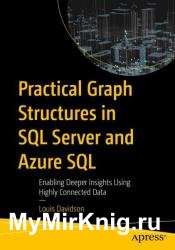 Название: Practical Graph Structures in SQL Server and Azure SQL: Enabling Deeper Insights Using Highly Connected Data Название: Practical Graph Structures in SQL Server and Azure SQL: Enabling Deeper Insights Using Highly Connected Data
Автор: Louis Davidson
Издательство: Apress
Год: 2023
Страниц: 244
Язык: английский
Формат: pdf (true), epub
Размер: 18.4 MB
Use the graph table features in Azure SQL that were introduced in SQL Server 2017 and further refined in SQL Server 2019. This book shows you how to create data structures to capture complex connections between items in your data. These connections will help you analyze and draw insights from connections in your data that go beyond classic relationships.
The graph examples in the book are useful for analyzing social media relationships, complex product-to-customer relationships, and any other type of data analysis in which indirect connections that otherwise might be missed using conventional techniques can be mined for their insight and business value.
Tree structures are covered, with emphasis on a structure commonly used by organizations to aggregate data at different levels of an organization. The book provides code examples of SQL Graph objects as well as an alternate tree implementation technique. Included is sample data (and data generators) for you to test for performance and choose the implementation approach that best suits your needs and that of your application.
If your job involves analyzing or storage of data elements that are connected in a networked topology, then this is the book that will help you bring the power of SQL Server to bear on that data and take advantage of your existing knowledge.
Like many computer science topics, graphs are also a fundamental mathematical concept. Some of the insights you can get from the math of graphs will help once we start analyzing data. So, to begin this book on graphs, I will provide a very cursory look at some mathematical concepts as I define what a graph is and how it can be used in software.
Graphs are based on two primary data structures: nodes (or in math terms, vertices), and edges. Nodes represent a thing that one might care about, much like a table in a relational database. Edges establish a connection between exactly one or two nodes (when the node count is one, it means the node is related to itself.) A graph is defined as being a set of nodes and a set of edges. In a graph database, a node is like most any table with attributes describing what the node represents. The edge is analogous to a many-to-many relationship table with at least attributes to represent the node that the relationship is from and which it is to. You will see that two major things set these new concepts apart from a relational implementation.
Any source code or other supplementary material referenced by the author in this book is available to readers on GitHub.
What You Will Learn:
Understand the graph model and the associated terms used in graph analysis
Store highly connected data in SQL Server and Azure SQL alongside existing relational data
Make full use of the graph table feature that is refined and enhanced in SQL Server 2019
Implement high performance tree structures that will make storing and querying tree data possible
Report on data associated with a tree structure to aggregate results at different levels
Contents:
1. Introduction to Graphs
2. Data Structures and Algorithms
3. SQL Graph Table Basics
4. SQL Graph Tables: Extended Topics
5. Tree Data Structures
6. Tree Structures, Algorithms, and Performance
7. Other Directed Acyclic Graphs
8. A Graph For Testing
Скачать Practical Graph Structures in SQL Server and Azure SQL: Enabling Deeper Insights Using Highly Connected Data
|